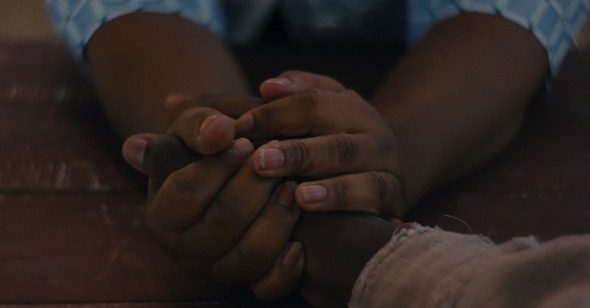Posting this list one day after the death of David Lynch, we cannot help but feel a pang. Losing Lynch is the end of not only an era but also a way of seeing and experiencing cinema, and maybe of being in the world. Why great art moves us the way it does is an eternal mystery, and this thing called critical writing is just one way we try to understand it. Lynch always rejected the idea that words can help explain cinema, believing that they were in a way inimical to the pure experience of the form. Of course, this has never stopped us from writing words, words, always more words, trying to interpret, reformat, reconceive, and exalt the cinema we love, which has often meant the cinema of Lynch. So it might seem silly or misguided to dedicate a written list of the year’s greatest cinema to Lynch, but in the event that we continue to do this for many more years and words, it’s only fair to acknowledge that all this magazine’s writing—over two decades of it now—has only ever been an attempt at understanding that which we often cannot fully grasp.
As usual, the year’s best films were determined by polling our major contributors from the last year. Their individual ranked lists were tallied by awarding the top film ten points, the second film nine points, and so on.
[Capsules written by Jordan Cronk, Caden Mark Gardner, Eric Hynes, Michael Koresky, Chloe Lizotte, Vikram Murthi, Jeff Reichert, Imogen Sara Smith, Chris Wisniewski, and Farihah Zaman.]

1. Nickel Boys
What do we expect from a literary adaptation? Fidelity? Lack of abridgement? A visual servicing of the text? The text should be paramount . . . except that the text itself was an adaptation—of life, experience, perception, ideas, feelings. Consulting Colson Whitehead’s historical novel The Nickel Boys for his second feature, RaMell Ross cuts to the source of the source, and honors both as well as anyone ever has. A singular artist and thinker who’s committed to articulating and exemplifying the singular in human experience, Ross treats anything familiar as a lie. And few things have lied worse, historically and implicitly, than a camera making images of Black people and their lives. His solution is not just to put the camera in service of the perspectives of Elwood and Turner, two 1960s teenagers effectively incarcerated in a Florida reform school, but to make the camera an extension of himself, DP Jomo Fray, and fellow camera operator Sam Ellison. What’s emphasized, what’s prioritized, what endures in our memory and on film, is the non-replicable quality and spontaneity of their seeing. Of their being. It’s a way of seeing that has character, temperament, personality, taste. The syncopated gaits of stockinged women on the street—that’s Elwood’s observation, and it’s the camera’s. It’s not representation, nor is it about representation, much as it’s not about adaptation. Or even evocation. The key difference between Ross and evident influence Terrence Malick is that the latter’s camera, though thirsty for the active, ephemeral, and singular, has a more spiritual provenance than a corporeal one. Its presence is lighter. It often feels at one with the atmosphere. For Ross, weight is everything. Weight is specific. Weight is presence. And no matter what the world does to them, no matter how much we lie to and about them, Elwood and Turner are as present in Nickel Boys as any characters in cinema have ever been. —Eric Hynes

2. Janet Planet
A widely reproduced strand of 21st century cinema has encouraged audiences, in an almost Pavlovian way, to respond to quiet, elegantly framed compositional tactics as though they’re deadpan funny. Elongated silences somehow read as “awkward,” eliciting laughter bred of shared estrangement. Despite seemingly familiar formal strategies, Janet Planet allows for no cheap catharsis—miraculous for a film revolving around an acupuncturist without the ability to relieve the tension in her own home life. That sounds like a funny conceit, but there’s a disarming seriousness to Annie Baker’s extraordinary debut, which burrows in with single mom Janet (Julianne Nicholson, howling behind a placid surface) and eleven-year-old daughter Lacy (Zoe Ziegler) in early nineties Western Massachusetts over the course of one sluggish summer. Baker, whose stage work is never small, evokes the personal in a manner that goes way beyond anecdotal. She invests every phantom-like interaction with a seemingly impossible combination of warmth and ominous portent: between Janet and Lacy, but also Janet and the trio of visitors (insomniac ex-boyfriend Will Patton, wayward former friend Sophie Okonedo, dubious potential mate Elias Koteas) who give the film its unnerving structure and who serve to elucidate and complicate our understanding of her. She is always dramatically decentered; we see her through Lacy who, bit by bit, with her owlish stare, gradually comes to realize her mother’s complexities and shortcomings, long before she’d ever be able to articulate the emotional convolutions that might come to define her own adulthood. To say the film is unsentimental is an understatement: nothing is even stated. As reflected in “Fourth Duino Elegy,” the Rilke poem read by Koteas’s Avi during his curtailed courtship of Janet, we all, like children, hope for some kind of divine intervention. Any deliverance out of the stranglehold of neuroses in Janet Planet may come, but it’s still down the road a bit, somewhere past the canopies of northern oaks that provide Lacy her adolescent cocoon. —Michael Koresky
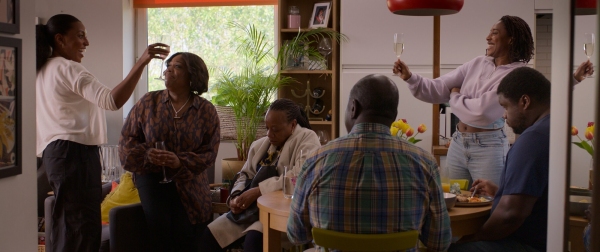
3. Hard Truths
Some years ago, Film Twitter™️ was gripped by a wave of anxiety in the face of the unlikable film character. What should an audience do when asked to spend a feature’s length with a mean person? How could one possibly engage with a work that centers people whom we wouldn’t want to DM? Thankfully, Mike Leigh gives not a shit about things tweeted in haste from fainting couches. Or reviews published in prominent outlets (see his, erm, brusque rejoinder to a Sight & Sound critique of Peterloo). Or, really, what you think. If he did, he might not have worked through his typical laborious, exacting, rehearsal-cum-gestation process to bring us Hard Truths and Pansy, its miracle of a protagonist. Pansy, it should be noted, is incredibly…difficult. As embodied by Marianne Jean-Baptiste, she’s frightened of most things and angry at everything else. She’s ferocious and spiteful, quick to insult and even quicker to claim injury and collapse into bed. For about the first third of Hard Truths, she’s so unhinged that it seems almost impossible that Jean-Baptiste could keep this act up without exploding, or that a viewer would want to keep watching. Yet this high-wire fusillade of rage and bitterness is all by Leigh’s and Jean-Baptiste’s careful design—the two masters daring us to realize we’re in the presence of a truly otherworldly level of performance. The film that contains Pansy generously provides space for her to just be the way she is—this is Mike Leigh, after all—and we are left simply to grapple with her fullness. The surrounding players are strategically curated—family members who are afraid of her (her near-catatonic husband Curtley and son Moses) or worried for her (her sister Chantelle, Pansy’s polar opposite), but who, crucially, haven’t given up on her. Yet. Hard Truths never sinks to the level of explanation, of revealing what happened to her to make her this way, instead asking us to live alongside her for a while, consider her struggles, avoid the conclusive. And perhaps even wonder if maybe she’s the sane one. If you’re left at the end wondering whether you liked Pansy, well, then you’ve missed the point entirely. —Jeff Reichert
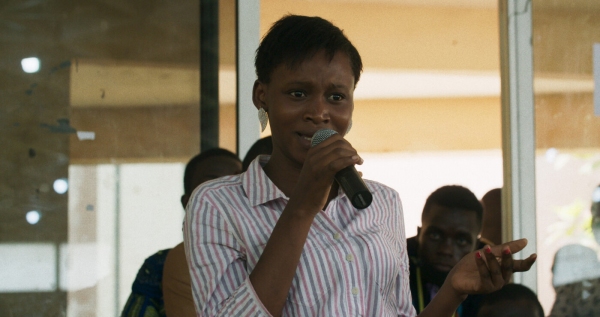
4. Dahomey
Mati Diop’s Golden Bear–winning follow-up to her feature debut Atlantics (2019) is another spellbinding tale of forced exile and return, haunted by questions of justice and healing from the wounds of colonialism. Her beguilingly uncategorizable new work documents the restitution of 26 treasures looted by France from the Kingdom of Dahomey (now Benin). Beginning and ending at night, it unfolds with dreamlike hyper-clarity, mixing formal rigor with unforced lyricism. Like Alice Rohrwacher’s enchanting La Chimera, Dahomey harnesses cinema’s animistic power to probe the relationship between modern people and sacred objects. One of the looted statues narrates his captivity and homecoming in an eerie, thunderous whisper; this emanation from the past is joined by the ringing voices of college students who vigorously debate the meaning of restitution and cultural heritage. No less eloquent is the wordless dialogue between the treasures and the people who come to see them in their new home: dignitaries in traditional finery and young laborers in orange vests speak through their gestures, movements, and gazes. Among the museumgoers, Diop’s camera catches a young boy dancing by himself, his spirit moved. Beside “the weight of the past,” he is the lightness of the future. —Imogen Sara Smith
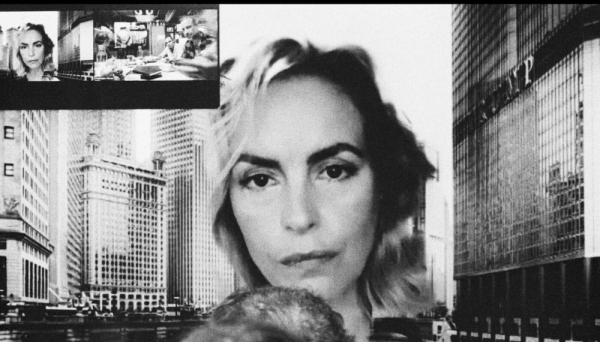
5. Do Not Expect Too Much from the End of the World
Radu Jude’s pandemic-era cinema is at once blazingly au courant and worlds apart from anything else being made today. Like Godard’s in the ’60s, Jude’s of-the-moment missives take an anarchic approach to politics, pop culture, and the never-ending spiral of contemporary image-making. For a director who claims to have no stylistic signature, there’s little mistaking the authorial sensibility behind such gleefully perverse accomplishments as the ur-Covid comedy Bad Luck Banging, or Loony Porn (2021), the art-historical disquisition The Potemkinists (2022), or, indeed, his latest narrative feature, Do Not Expect Too Much from the End of the World, a two-part, 163-minute ride through the unforgiving streets of the modern gig economy. In the first section, which is interspersed with symbolic echoes of an obscure 1981 Romanian film about a lonely female cab driver, overworked production assistant Angela (Ilinca Manolache) zigzags across Budapest to audition injured workers for a work-safety video commissioned by a multinational corporation; between visits, she adopts an online edgelord persona to broadcast hate speech from behind a face app. If these diatribes don’t pay the bills (at least for now), it’s certainly more liberating than PA work—and likely more fulfilling. The second half, meanwhile, is given over to a fixed 40-minute shot of the chosen worker (Ovidiu Pîrsan) being coached through his testimonial to essentially take responsibility for the accident that’s left him paralyzed. With its offhand visual and verbal references to everything from the Lumière brothers to Bob Dylan to the war in Ukraine, it’s the filmic equivalent of a TikTok feed distilled to a single take. As engrossing as it is uncomfortable, it’s a sequence indicative of a film—and a year—in which tragedy and absurdity went hand in hand. —Jordan Cronk
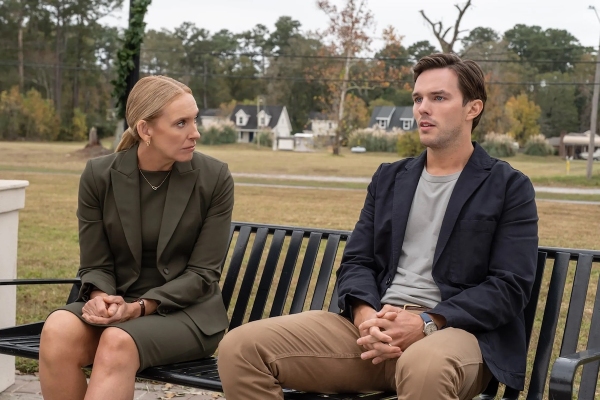
6. Juror #2
What would you do if you accidentally did something to hurt someone, and didn’t even realize it? If you discovered after the fact, when the damage had already been done? And what if, by doing nothing, you could preserve yourself at the cost of someone else, but in owning up to your mistake, you risked everything? This is the ethical dilemma posed by Clint Eastwood’s Juror #2, ostensibly in depicting the reaction of titular juror Justin Kemp (Nicholas Hoult) to the awful discovery that he must decide the fate of a man charged with a murder he didn’t commit—because Justin caused the death unknowingly in a hit-and-run. The deft gambit of Jonathan Abrams’s script is to subtly shift that ethical dilemma to the prosecutor in the case, Faith Killebrew (Toni Collette), whose political ambition stands at odds with her duty to “justice” (whatever that word means). As the trial progresses, Justin and Faith are, by turns and often at the same time, mirror images and each other’s antagonists. Each makes decisions at first informed by naïve conviction and slowly complicated as the implications of their actions—for themselves, for others—become clearer. By charting their paths through these choppy moral waters in parallel, Eastwood and Abrams package a disturbingly untidy moral parable as an elegant, briskly told courtroom drama and procedural. The results could have been writerly. But Eastwood, whose films over the decades have given us great performances from such varied stars as Hilary Swank, Bradley Cooper, Morgan Freeman, and Meryl Streep, proves once again that he’s a surprisingly underrated director of actors. Hoult is fantastic, at turns sympathetic and sinister, but Collette is especially brilliant, her face registering every pang, anxiety, hope, and uncertainty needed to give this parable a truly human dimension. Juror #2 demonstrates that sturdy filmmaking need not be boring and that classical storytelling need not be pat or easy. It willfully demands that its audience wrestle with the questions it poses after it cuts to black. Unfortunately, for American cinema, they don’t make ’em like they used to. Lucky for us, with Juror #2, Eastwood proved once again he still does. —Chris Wisniewski
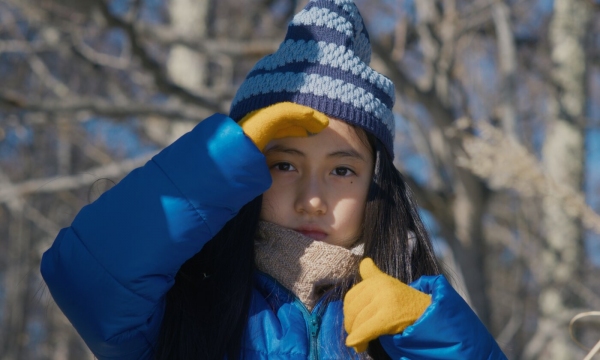
7. Evil Does Not Exist
At first, Evil Does Not Exist is elusive: it’s tricky to know where the film is going, and yet Ryusuke Hamaguchi’s narrative artistry is so direct, so clear, so uninterested in belaboring its mastery. The film begins by looking through the eyes of a child, Hana, upward toward the canopy of a forest, treetops forking against a gray sky. The camera glides backwards, ghostlike, accompanied by an impassioned string overture by Eiko Ishibashi; the combined effect of sound and image is elegiac, overwhelming, eerie—equally Georges Delerue and Bernard Herrmann. Hana lives with her dad, a quiet and spacey widower named Takumi, in a village two hours outside of Tokyo. In a town meeting, the community learns of a company’s thoughtless plans to develop a glamping site on their home turf; the scene rivals Frederick Wiseman as the townspeople attempt to reason with the project leads, speaking to the disastrous domino effect of a carelessly implemented septic tank. The villagers emphasize the relationship they have nurtured over time with this place, situating themselves within a larger natural ecosystem. “We are all outsiders here,” explains Takumi, thinking of the importance of care, of a sustainable place for Hana’s generation to live—but, he admits, even the most responsible contract with nature is itself a sort of pillaging. Like a cascading stream, Ishibashi’s string motifs stairstep down into harmonies, then reunite in unison, an echo of the village’s bubbling brook: in early scenes, it calmly trickles, a source of stability, then seems to rush with greater urgency toward the film’s haunting climax, set on a nightmare plane for Takumi. The groundwork for this unsettling swerve, such a shock upon a first viewing—a fate indelibly sealed in the gaze of a deer, eyes like inkwells—was there all along. We are all outsiders. Perhaps Hamaguchi’s parable is so unshakable for how openly he lays this truth out to see. —Chloe Lizotte
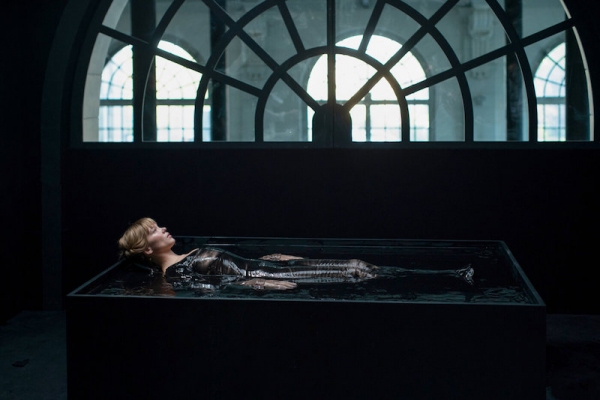
8. The Beast
In a letter to the poet and essayist A. C. Benson, Henry James wrote, “I have the imagination of disaster—and see life as indeed ferocious and sinister.” The disasters in The Beast assume different forms—a great flood, violent misogyny, technological takeover—but they always announce themselves with a foreboding that slowly poisons the mind and spirit. Inspired by James’s 1903 novella The Beast in the Jungle, Bertrand Bonello takes the narrative’s central metaphor of the beast as paralyzing dread, the kind that damns its prey to a life of passionless passivity, and transposes it onto visions of the rarefied past, the crude present, and a dehumanizing future. Would-be lovers Gabrielle (Léa Seydoux) and Louis (George MacKay) are doomed across all three timelines, whether they’re moving together as upper-crust peers through the repressive miasma of Belle Époque Paris, or the former is stalked by the latter in the vacuous anonymity of 2014 Los Angeles. Despite superficial differences in setting, a pervasive fear—of love, but also the all-too-ordinary fate of merely observing life instead of participating in it—connects the tripartite versions of the couple, which Bonello conveys through stomach-pit-rattling anxiety that genuinely earns positive comparisons to David Lynch. The Beast provocatively addresses our miserable contemporary moment not only by invoking incel rhetoric or openly acknowledging the horrors of AI but mostly by understanding the inherent tragedy of alienation being an organic response to an unfeeling world. “It wasn’t a thing of a monstrous order,” James writes about the beast in the jungle, “not a fate rare and distinguished; not a stroke of fortune that overwhelmed and immortalized; it had only the stamp of the common doom.” Gabrielle’s final scream of anguish, which grinds The Beast to a halt, pierces nerve endings because of how normal—dare I say, banal—the reaction is to a futurethat promises nothing but a ferocious, sinister life. —Vikram Murthi
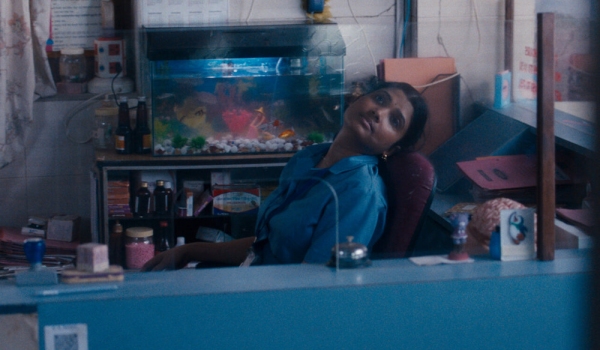
9. All We Imagine as Light
Payal Kapadia’s first fiction feature sees the lives of three women—inquisitive nurse-in-training Anu, her reserved but compassionate supervisor Prabha, and stubbornly independent widow Parvaty—intertwine at the bustling Mumbai hospital where they work. As in her debut film, A Night of Knowing Nothing, the director is not overly concerned with the categorizations we use to connote truth, like “documentary” and “fiction”; she weaves elements of one into the other to illuminating, harmonious effect. Her first film found space for speculative imagination in nonfiction, the better to excavate interior worlds; the second introduces nonfiction elements to a scripted narrative, even opening the film with testimonies of real-life Mumbai workers, grounding the lovingly fabricated characters so that they might better reflect the women who inspired their creation. Similarly, the beauty of the city’s fluorescent-lit playgrounds and night markets emerges through ardent attention, like that given to ordinary objects like a rice cooker or a notebook, or humble locations like the nearly empty beach where the women find themselves drinking moonshine under moonlight. The resulting experience is not magical realism, so much as realistic magic. By harnessing rather than excessively manipulating what cinema has to offer, Kapadia reaches a startling emotional truth that shines equally through the mega-urban public transportation and the sterile sheen of hospital examination tables. All We Imagine as Light is the first Indian film to play Cannes in thirty years, and the first to win the Grand Prix; despite the accolades abroad and strong reception at home, its country of origin declined to put it forward for the Academy Award for Best International Feature Film. Considering the increasing Hindu Nationalism in India, one of many nations globally to experience a government hurtling towards a fanatical religious right, the snub has prompted speculation that it’s the romance between Anu, who is Hindu, and her Muslim lover, Shiaz, that troubled the Indian film board. That the sweetness of Kapadia’s depiction of interfaith love could cause such offense is a reminder of just how radical tenderness and honesty can be, and what we really mean when we talk about the personal as political. By centering the quest for autonomy in her finely drawn characters, Kapadia deftly asserts her own. —Farihah Zaman
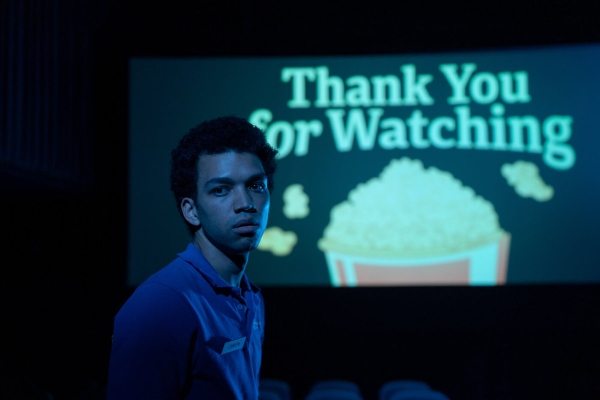
10. I Saw the TV Glow
I first watched I Saw the TV Glow alone in a screening room on a wintry weekday. Afterwards, dazed, I realized five minutes into my walk back to my train that I had been heading in the wrong direction. I Saw the TV Glow is less a coming-of-age for its main character, Owen (Justice Smith), than a haunting narrative of someone who never grows up. He ages, yes, but he stays in his shell. The egg does not crack. Whether that is tied to trauma, an unhealthy attachment to nostalgia that ultimately unravels, internalized self-hatred, or some cocktail of all three, the film, radically, never takes Owen off the ramp of his untenable situation, despite images that spell out “THERE IS STILL TIME.” Those signs are for the film’s audience as much as for Owen, and writer-director Jane Schoenbrun presents Owen's story not to uplift but as a mirror for those viewers who may have already lived through or are living within that moment of denial. Many within the trans community, film academia, and mainstream culture have been eager to size up the recent run of trans-authored films, whether they are “the first trans masterpiece,” “a trans masterpiece,” part of a “new trans cinema,” or a “movie of the moment,” and have tried to fit TV Glow into that conversation. We are all trapped under the gaze of society’s expectations, but breaking away and shifting toward the path of your idealized self, however risky, frightening, and precarious, can still offer something better. TV Glow presents this way forward with the character of Maddy (Brigette Lundy-Paine), whose journey comes while teetering toward potential annihilation. Owen, on the other hand, chooses to loop back to the false comforts of his existence, only to find that watching reruns may offer diminishing returns. —Caden Mark Gardner
